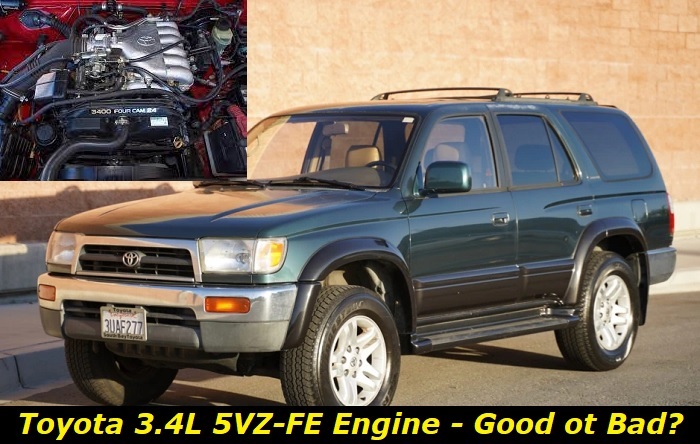The Toyota 3.4L engine, also known for its 5VZ-FE designation, is characterized by its reliability. It may not be a total stand-out when it comes to power compared to its direct rivals in the market, but it sure did forge its own identity over the competition by being something that drivers can truly depend on.
The consensus on the Toyota 3.4L engine is mainly on a positive note, thanks to its long-lasting engineering and pretty decent specs. However, it is still known for its few problems. In this article, we will look at these factors to determine whether or not the engine is really as good as they say.

Key features and my opinion about the engine
- Production years:1995-2004
- Average lifespan of 5VZ-FE:260,000-290,000 miles
- Fuel supply type:port injection
- Power range:190 hp
- Fuel efficiency:awful
- Engine block material:cast-iron
- Engine reliability score:high
- The most common problems:oil consumption, overheating due to cooling system flaws.
Durability of the Toyota 3.4L Engine
A properly maintained Toyota 3.4L engine can reward you with decades of excellent reliability. That means you should always watch the quality and level of its fluids while keeping with its maker's recommended maintenance intervals and parts replacements. This is evidenced by 90s to early 2000s models equipped with the power unit that are still being driven on our roads today.
According to the proud owners of the engine, its average lifespan can go up to 200,000 miles with only minor repairs. Some even boasted of being able to push the powerplant by over 300,000 miles.
Common Problems Linked to the Toyota 3.4L Engine
The Toyota 3.4L engine stands out from other alternatives due to its high level of durability. However, that does not mean that it is impervious to problems.
Considering the age of the engine now, there's a big chance that you may run into the following problems, which are known to be common in this product:
1. Worn Timing Belt
If you have a Toyota 3.4L engine, then you should know by now the importance of changing the timing belt every 90,000 miles or as soon as signs of its breakage are already imminent. This crucial component is responsible for keeping the engine's valves in sync with the pistons. If it fails, serious engine damage can occur.
Worn timing belts will usually display symptoms such as loud noises coming from the engine bay, misfiring, or reduced power and performance. If these symptoms are ignored, it can lead to catastrophic engine failure.
Fortunately, diagnosing a worn timing belt is relatively straightforward. One of the most common causes is simply due to wear and tear. Over time, the belt will begin to degrade and break down. Another possible cause is an issue with the tensioner or pulleys. These parts can also wear down over time, or they may become damaged due to a collision.
If you suspect that your timing belt is worn, it's important to have it checked out by a qualified mechanic as soon as possible. They will be able to diagnose the problem and recommend the best course of action, which may involve replacing some or all of the timing belt components. In some cases, a complete engine rebuild may be necessary. However, addressing the issue early on will help to minimize the amount of damage and repairs needed,
2. Oil Leaks
Engine oil is crucial for the proper function of any engine, and the Toyota 5VZ-FE engine is no exception. The oil helps lubricate the engine parts, keeping them cool and reducing friction and wear. Over time, the oil can break down and become less effective, so it needs to be regularly changed.
One of the most common problems with engine oil is leaks. Oil leaks can happen for a number of reasons, including worn or damaged seals and gaskets, loose connections, or simply because the oil level is too high. If you suspect an oil leak, it's important to have it checked out as soon as possible as it can lead to serious engine damage if left unchecked.
There are a few telltale signs of an oil leak, including low oil levels on the dipstick, oil stains on the ground underneath the car, or burning oil smells. If you notice any of these symptoms, it's important to take your car to a mechanic and have it checked out.
Once you're at the mechanic, they will likely do a pressure test to check for leaks. If they find a leak, they will then need to determine the cause and make the necessary repairs. This could involve replacing seals or gaskets, tightening connections, or simply draining and refilling the oil.
If you notice any signs of an oil leak, it's important to take your car to a mechanic as soon as possible. Ignoring the problem could lead to serious engine damage.
3. Cracked Head Gaskets
The head gasket is a vital component of the Toyota 3.4L engine. It seals the combustion chamber, preventing gases and fluids from leaking into adjacent areas. Head gasket cracks can cause symptoms like loss of compression, oil leaks, coolant leaks, and overheating.
Compression loss is perhaps the most common symptom of a cracked head gasket. If the head gasket is damaged, it will no longer be able to effectively seal the combustion chamber. This will cause a loss of compression, and the engine will run rough.
Oil leaks are another common symptom of a cracked head gasket. If the head gasket is damaged, oil will be able to leak past it and into the combustion chamber. Moreover, this can cause the engine to smoke, and it can lead to a loss of oil pressure.
Coolant leaks are another symptom of a cracked head gasket. If the head gasket is damaged, coolant will be able to leak past it and into the combustion chamber. This can make the engine overheat, and it can also lead to a loss of coolant.
If the head gasket is not repaired immediately, the problem will only get worse. The engine will continue to lose compression, oil, and coolant. Eventually, the engine will seize up and fail.
There are a few ways to diagnose a cracked head gasket. A compression test can be used to check for loss of compression. An oil pressure test can be used to check for oil leaks. And a coolant pressure test can be used to check for coolant leaks.
If the head gasket is indeed cracked, it will need to be replaced. This is a relatively straightforward repair, but it can be expensive. The head gasket is a vital component of the engine, and it should not be taken lightly.
If you think you have a cracked head gasket, have it diagnosed by a professional as soon as possible. Ignoring the problem will only make it worse, and it could eventually lead to engine failure.
4. Carbon Build-Up
Carbon build-up in the engine is one of the most common problems that can occur in Toyota 3.4L engines as they age, are subjected to frequent use in stop-and-go traffic, and are exposed to dusty or wet environmental conditions. Although this can occur in just about any part of the engine bay, the most common parts affected by this in the 5VZ-FE are the intake valves and combustion chamber. Over time, these deposits can cause the engine to run less efficiently and can eventually lead to engine failure.
The symptoms of carbon build-up include reduced power, increased fuel consumption, rough idling, and misfires. If left untreated, the contamination can cause serious damage to the engine, including piston failure and cylinder head warping.
To diagnose carbon build-up, a mechanic will perform a visual inspection of the intake valves and combustion chamber. They may also use a borescope to get a closer look at the deposits. Once the cause of the build-up is determined, the mechanic will recommend the best course of action to clean or replace the affected parts.
If you suspect that your engine has carbon build-up, it is important to have it inspected by a qualified mechanic as soon as possible. Ignoring the problem can lead to serious engine damage that can be expensive to repair.
At their early stages, the carbon build-up can be removed via cleaning solutions. But when they grow thicker and have already led to serious corrosion, it would be best to replace the valves, rings, and other parts that have taken a hit from the problem. We also highly suggest using higher-octane gasoline and to avoid extended idling to prevent carbon build-up. One more preventive measure that you may want to consider is the use of fuel additives to bring out the best performance of your engine as you prolong its life.
Toyota 3.4L Engine Key Specifications
The Toyota 3.4L 5VZ-FE engine is a V6 power unit used from the 1993 to 2004 model year vehicles of the Japanese brand. Its popular applications include the Tacoma pickup, Tundra pickup, T-100 pickup, 4Runner SUV, and Land Cruiser Prado SUV.
The engine features a dual overhead camshaft (DOHC) architecture coupled with a cast iron block and aluminum heads. It has a compression ratio of 9.6:1 and its fuel delivery is managed via a sequential multi-port fuel injection (MFI) system.
The output of the Toyota 3.4L engine varies depending on the model carrying it. For example, the 4Runner had it pegged at 183 hp and 217 lb-ft of torque but the Tacoma allowed it to peak at 190 hp and 220 lb-ft.
Conclusion
Not to sound like a broken record, but based on the very few problems commonly associated with it plus its over-the-top durability and lifespan, the Toyota 3.4L engine is truly a very reliable and durable machine. This is definitely an excellent partner for big vehicles that are usually driven on a daily basis. Likewise, it can also be a nice companion for recreational and work-related trips.
About the authors
The CarAraC research team is composed of seasoned auto mechanics and automotive industry professionals, including individuals with advanced degrees and certifications in their field. Our team members boast prestigious credentials, reflecting their extensive knowledge and skills. These qualifications include: IMI: Institute of the Motor Industry, ASE-Certified Master Automobile Technicians; Coventry University, Graduate of MA in Automotive Journalism; Politecnico di Torino, Italy, MS Automotive Engineering; Ss. Cyril and Methodius University in Skopje, Mechanical University in Skopje; TOC Automotive College; DHA Suffa University, Department of Mechanical Engineering






Add comment